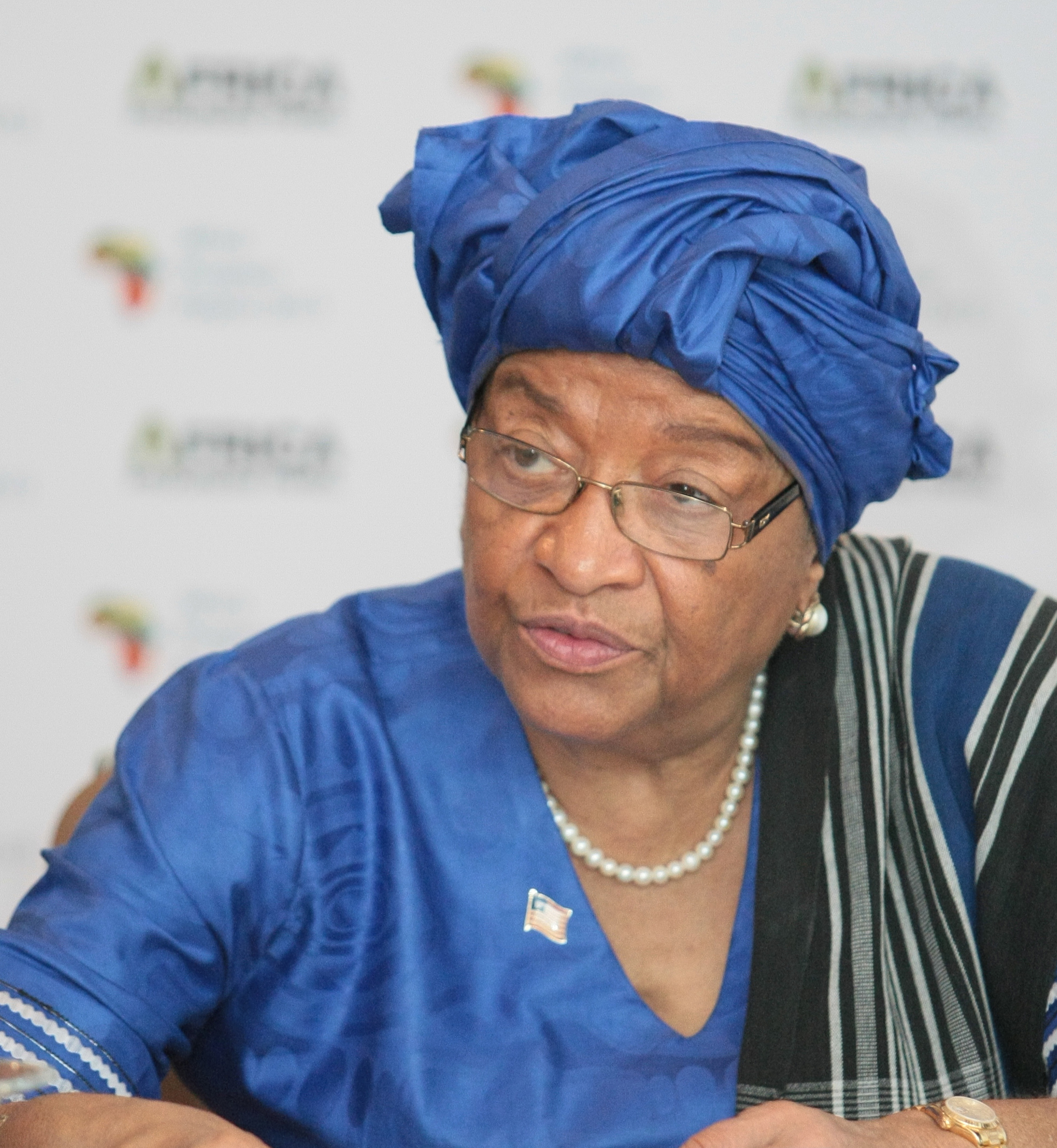Liberia is the oldest republic in sub-Saharan Africa. The country was founded on the west coast of Africa by freed slaves who were sent there by a colonization society in the United States. These freed slaves were joined by others who had been freed from slave ships bound for the United States. The name Liberia is derived from a Latin phrase meaning free land.
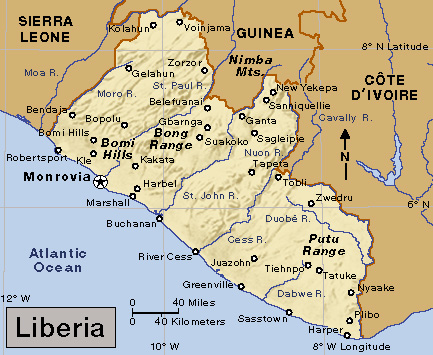
Liberia’s land features include mountains, forested plateaus, and a rugged coastline. The country has a hot, humid climate. Most of Liberia’s workers farm for a living. Monrovia, the country’s capital, is also its largest city.
Government
Under Liberia’s Constitution, a president heads the government, and the legislature consists of a Senate and a House of Representatives. The voters elect the president to a six-year term, senators to nine-year terms, and House members to six-year terms. All Liberian citizens 18 years of age or older are allowed to vote.
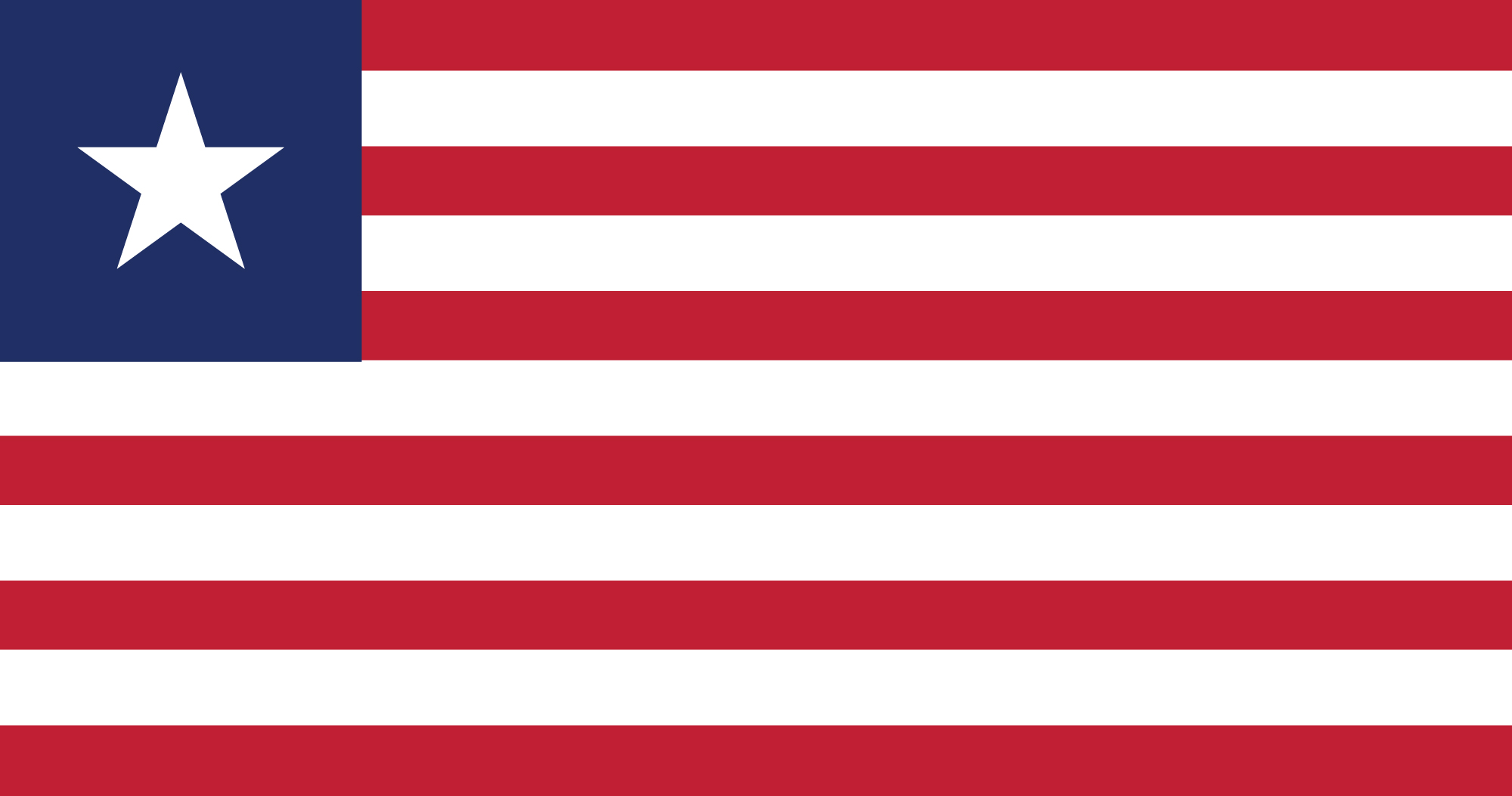
Liberia is divided into 15 counties. Each county has a superintendent appointed by the president.
A Supreme Court heads Liberia’s main court system. The Supreme Court has a chief justice and four associate judges, all appointed by the president. Another court system judges cases based on African customary law.
People
Almost all of Liberia’s people are members of African ethnic groups. Small groups of Americans, West Europeans, Lebanese, and Asian Indians also live in the country. The African population is made up of two main groups—the indigenous (native) Africans, whose ancestors have lived in the area for hundreds of years; and the Americo-Liberians, who are descended mainly from African American settlers sent from the United States.
Indigenous Africans account for about 95 percent of Liberia’s people. They are divided into 16 ethnic groups, each with its own language, customs, history, and territory. The largest groups are the Kpelle, who live in central Liberia, and the Bassa, who live along the coast. Other groups include the Gio, Krahn, Kru, Mano, and Vai.
The Americo-Liberians make up about 5 percent of the population. They live in coastal cities and towns. In general, the Americo-Liberians have been far better off than the indigenous Africans. Before a group of indigenous Africans revolted in 1980, Americo-Liberians controlled the country’s political system. The revolt brought indigenous Africans to power.
City life.
Since the 1990’s, civil war and unrest have destroyed large areas of Liberia’s cities and towns. During the 1980’s, many urban Liberians had electric power and running water in their homes. Monrovia had large buildings and stores, movie theaters, and busy streets. Today, most of these features of urban life are gone. Many of the expensive homes once occupied by Americo-Liberians are abandoned or in disrepair. Most people who are still in the cities and towns live in small, tin-roofed wooden houses or in temporary dwellings. 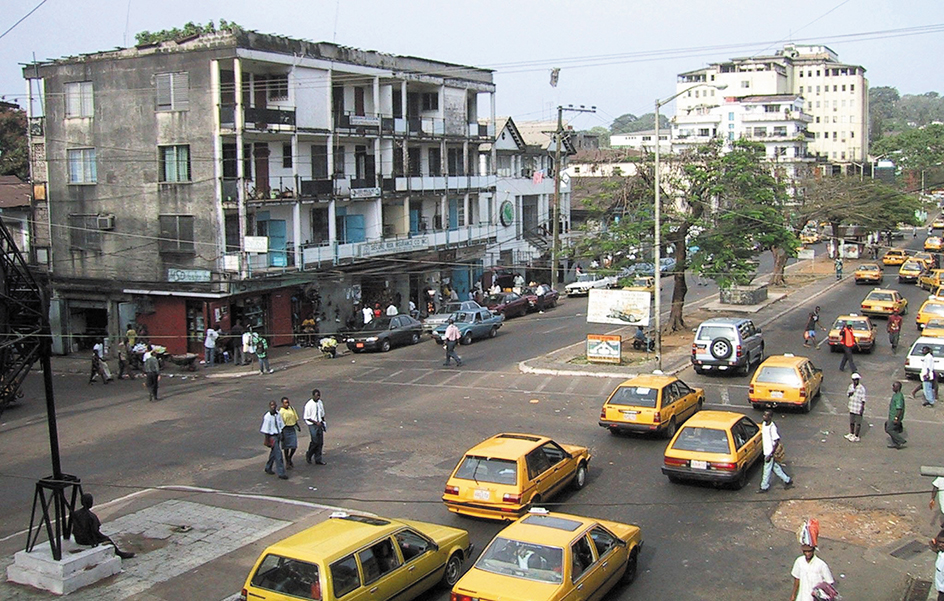
Large numbers of urban Liberians today are unemployed as a result of the civil unrest. Many women who live in urban areas travel to rural areas daily to work on farms. Family life is important in Liberia. Extended families—in which married children and their offspring live with the parents—are common in the cities.
Rural life.
In the rural areas, people live in small villages. Most people live in mud houses with thatched roofs. Almost no homes in rural Liberia have electric power or indoor plumbing.
Most people in rural Liberia work as farmers. Many people who live along the coast fish for a living or work aboard ships. As in the urban areas, extended families are common in Liberia’s rural areas.
Religions and languages.
About 40 percent of the people of Liberia are Christians, and about 20 percent are Muslims. Many Liberians—especially those in rural areas—follow the traditional religious beliefs of their ethnic group. English is Liberia’s official language. It is used in government and business and is taught in the schools. Each African ethnic group has its own language, and some also have several distinct dialects.
Education.
Liberia’s school system includes six years of elementary school and six years of secondary school. The government supports some schools. Others are run by missionaries. By law, children must attend all 12 grades. However, only about 60 percent of the children fulfill this requirement. School attendance is much lower for girls than for boys. Liberia lacks an adequate number of schools, especially in the rural areas. The country also has shortages of teachers and teaching materials.
Liberia has one university and a few other institutions of higher education. Only a small percentage of the people of Liberia attend school beyond the secondary level. About half of the country’s people can read and write.
Land and climate
Liberia has a rugged coastline. A narrow coastal plain extends inland from the coastline, and the land gradually rises to a plateau region with low hills. This region includes the Bomi Hills and the Bong Range. Higher elevations of the plateau region have forests of evergreens and deciduous trees (trees that shed their leaves annually), including ironwood and mahogany. Its valleys have grasses with scattered trees. Highlands in the northern and northwestern parts of Liberia include the Wologizi and Nimba mountain ranges. Liberia’s most important rivers are the Cavally (also spelled Cavalla), which forms Liberia’s border with Côte d’Ivoire; and the St. Paul, which flows through the mountains in the north.
Liberia’s climate is hot and humid. The average annual temperature is 80 °F (27 °C) along the coast. Most of Liberia has a dry season and a rainy season. On the coast, the dry season lasts from December to March. However, the dry season lasts longer in inland areas of the country. Annual rainfall on the coast of Liberia averages 200 inches (510 centimeters). Inland areas receive about 85 inches (220 centimeters) of rain each year.
Liberia once had much wildlife. But hunters killed most of the wild animals. Some elephants, crocodiles, pygmy hippopotamuses, antelopes, and leopards still live in the east and in the northwest.
Economy
Liberia has plentiful natural resources, including water, minerals, and forests, and it has a climate favorable to agriculture. But civil war and unrest during the 1990’s and early 2000’s severely damaged the country’s economy. Many businesspeople left Liberia, and only some returned. The economy began to recover after the war, but an outbreak of the Ebola virus in the mid-2010’s further hampered growth.
Before the fighting, Liberia had been a producer and exporter of iron ore and basic products such as rubber. The country now has a subsistence economy—that is, an economy based largely on people producing food and other goods for their own use, rather than for export. Liberia has a high unemployment rate, and many of its people live in poverty. Foreign assistance is important to the country’s economy.
Agriculture
is the chief occupation in Liberia. Rubber is Liberia’s main agricultural export. Large rubber plantations owned by foreign companies employ many Liberians. Other crops exported from Liberia include cacao, which is used to make cocoa, and coffee. Bananas, cassava, corn, palm oil, rice, and sugar cane are the chief food crops. Many farmers also raise chickens, goats, pigs, and other livestock. 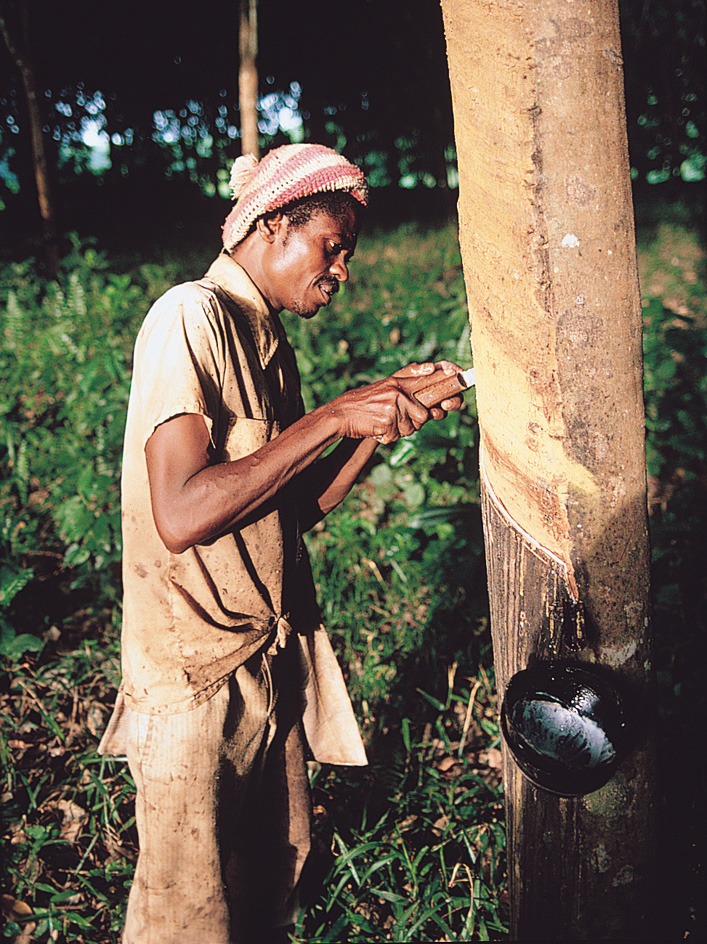
Most Liberian farmers use old-fashioned farming methods, and few have modern farm machinery. Liberia’s farmers produce goods mainly for their own families, and so there is little to sell to city dwellers. As a result, the country must import much of its food.
Liberia has some large forest areas. Timber cut from these regions is exported, used for firewood, or made into lumber.
Manufacturing and mining
play a small role in Liberia’s economy. Less than 5 percent of Liberia’s workers are employed in these two sectors. Factories in Liberia produce beverages and cement and process farm, forest, and mining products. The country mines a small amount of diamonds and gold.
International trade.
Liberia imports much more than it exports. The country’s leading trade partners are Japan, Malaysia, Singapore, South Korea, and the United States. Liberia imports chemicals, machinery, petroleum, rice, and transportation equipment. Rubber is the country’s leading export. The country also exports cocoa, coffee, diamonds, and iron ore.
Transportation and communication.
Most of Liberia’s roads are unpaved. Few Liberians own an automobile. City dwellers usually walk or take taxis or buses. Most rural Liberians travel on foot. Two international airports are in or near Monrovia. Buchanan and Monrovia have seaports.
One of the largest merchant fleets in the world is registered under the Liberian flag. But only a few ships are owned by Liberians. The rest are owned by people from other countries who register their ships in Liberia because taxes are lower there.
Liberia’s newspapers are published in English. The government operates a radio station. The country also has some privately owned radio and television stations.
History
Early days.
The ancestors of today’s native Liberians probably came from kingdoms in Sudan between the 1100’s and the 1500’s. In the 1400’s, Portuguese explorers began to trade with the people who lived along the coast of what is now Liberia. The Portuguese traded for ivory, spices, and slaves who were taken from the inland region. The traders greatly prized a spice called malagueta pepper, which they called the “grain of paradise.” Thus, the region became known as the Grain Coast.
The Liberian settlement.
In the late 1700’s and early 1800’s, many white people in the United States became concerned over the existence of freed black slaves in their country. Some slaveowners believed that the existence of freed slaves increased discontent among those still in slavery. Other white people objected to the integration of the freed slaves into their society. In 1816, a group of whites set up the American Colonization Society (ACS) to return free blacks to Africa. The ACS bought land along the Grain Coast and started a settlement. They named it Monrovia, after President James Monroe. In 1822, the first group of freed slaves arrived at the settlement by ship. They were joined by many Africans whom the U.S. Navy had removed from ships that were illegally transporting slaves. The settlers faced many difficulties. They had trouble finding food. Many died from disease. The native Africans feared losing their land to the Americo-Liberians and often attacked the settlers.
In 1838, the Monrovia settlement joined with others that had been established in the region to form the Commonwealth of Liberia. The commonwealth handled some of its own affairs, but it was controlled by the ACS. Joseph Jenkins Roberts, an Americo-Liberian from Virginia, became governor. Jenkins tried to increase trade income by establishing customs duties (taxes on imports and exports). But European traders refused to recognize the right of the commonwealth to do so. Disputes also arose between the settlers and the ACS. Many Americo-Liberians sought independence, and members of the ACS resented the expense of supporting Liberia. Liberia became an independent nation on July 26, 1847. Roberts became its first president.
The Republic of Liberia.
The customs duties Liberia placed on its imports and exports increased the cost of trading with the country. Liberia’s trade declined and its economy suffered. In the late 1800’s and early 1900’s, Liberia’s government was forced to take large loans in foreign countries to pay its bills. It could only obtain funds to repay its debts by raising customs duties.
In 1926, the Liberian government agreed to lease large amounts of land to the American Firestone Company for rubber plantations. The rent paid by the company provided important income to the country. The plantations also created jobs for many Liberians.
William V. S. Tubman became president of Liberia in 1944. Tubman was determined to develop the economy and to integrate the Americo-Liberians and indigenous African populations. During Tubman’s rule, foreign trade expanded and the mining of iron ore grew considerably. Tubman’s policies aimed at providing more political and economic opportunities for the indigenous Africans. But Tubman still wanted the real power to remain with a small group of Americo-Liberian families that had dominated Liberia for most of its history.
The 1970’s and 1980’s.
Tubman died in 1971. He was succeeded by Vice President William R. Tolbert, Jr., another Americo-Liberian. Tolbert tried to follow Tubman’s policies, but he faced major problems. Iron ore and rubber prices dropped, and the economy suffered badly. In 1979, a rise in the cost of rice caused riots and looting. Under Tolbert’s rule, the rich prospered while the poor became poorer. In 1980, a group of military men from the indigenous Liberian population killed Tolbert and took control of the government. They installed Samuel K. Doe, an army sergeant, as head of state.
In 1985, elections were held to choose a president and a legislature. Doe was declared winner of the presidency, and his party—the National Democratic Party of Liberia—was awarded a majority of seats in the legislature. However, many people believe the elections were rigged (fixed) by Doe and his supporters. Doe’s new government took office in 1986. During his reign, Doe had many opponents imprisoned or killed.
Civil war.
A rebellion against Doe began in late 1989, starting a civil war. The rebels, known as the National Patriotic Front of Liberia (NPFL), were led by Charles Taylor, a former government official. The NPFL and a breakaway rebel group, the Independent National Patriotic Front of Liberia (INPFL), fought with each other and with the Armed Forces of Liberia (AFL). The NPFL and INPFL consisted mainly of members of the Gio and Mano ethnic groups. The AFL consisted mainly of Doe’s ethnic group, the Krahn. In August 1990, West African peacekeeping forces were sent to Liberia. In September, the INPFL killed Doe. In October, the West African forces gained control of the capital, Monrovia, and placed it under the control of a temporary government. The NPFL controlled much of the countryside. In 1996, the warring factions signed an agreement ending the fighting.
In July 1997, Taylor was elected president, and his National Patriotic Party gained control of the legislature. During Taylor’s presidency, fighting erupted between Liberian government forces and opposition groups, such as Liberians United for Reconciliation and Democracy (LURD). The fighting displaced many thousands of people. In 2001, the United Nations (UN) imposed sanctions on Liberia for its support of rebels in Sierra Leone. In 2003, the Liberian opposition groups intensified their war against Taylor’s government. They gained control of about two-thirds of the country and launched assaults on Monrovia, killing more than 1,000 people. In June 2003, a UN-backed war crimes court charged Taylor with having supported rebels in Sierra Leone. In August, West African peacekeeping forces began arriving in Liberia. That month, in response to domestic and international pressure, Taylor stepped down as president and went into exile in Nigeria.
Soon afterward, Liberia’s interim leaders signed a peace deal with Liberian rebel groups, and the rebels withdrew from Monrovia. Some fighting continued in other parts of the country. The UN authorized a peacekeeping mission and began sending thousands of troops to Liberia. Under the peace deal, a transitional power-sharing government took control of the country in October 2003. More than 200,000 Liberians died as a result of the war, and about 1 million others fled to refugee camps in neighboring countries.
Recent developments.
In October 2005, elections were held for the legislature and for president, and presidential runoff elections took place in November. Ellen Johnson-Sirleaf won the election, becoming the first woman elected president of an African country. She was reelected in 2011.
In March 2006, Nigeria gave former President Charles Taylor to the Liberian government. In April, Taylor pleaded not guilty to charges of war crimes committed during Sierra Leone’s civil war (1991-2002). From 2007 to 2012, Taylor stood trial at a UN-backed war crimes court in The Hague, in the Netherlands. In 2012, the court found Taylor guilty of supporting the rebels and sentenced him to 50 years in prison. In 2016, the UN peacekeepers who had been in Liberia since 2003 returned responsibility for the country’s security to the Liberian government.
In December 2017, senator and former soccer player George Weah was elected president. He took office in January 2018. In November 2023, former vice president Joseph Boakai was elected president.
